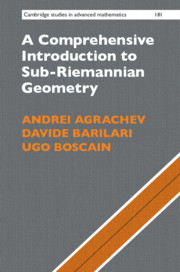
-
Select format
-
- Publisher:
- Cambridge University Press
- Publication date:
- October 2019
- October 2019
- ISBN:
- 9781108677325
- 9781108476355
- Dimensions:
- (228 x 152 mm)
- Weight & Pages:
- 1.19kg, 762 Pages
- Dimensions:
- Weight & Pages:
You may already have access via personal or institutional login
Book description
Sub-Riemannian geometry is the geometry of a world with nonholonomic constraints. In such a world, one can move, send and receive information only in certain admissible directions but eventually can reach every position from any other. In the last two decades sub-Riemannian geometry has emerged as an independent research domain impacting on several areas of pure and applied mathematics, with applications to many areas such as quantum control, Hamiltonian dynamics, robotics and Lie theory. This comprehensive introduction proceeds from classical topics to cutting-edge theory and applications, assuming only standard knowledge of calculus, linear algebra and differential equations. The book may serve as a basis for an introductory course in Riemannian geometry or an advanced course in sub-Riemannian geometry, covering elements of Hamiltonian dynamics, integrable systems and Lie theory. It will also be a valuable reference source for researchers in various disciplines.
Reviews
‘It is wonderful to have a wide swath of the work of this school explained clearly and set down in one place. I am understanding some of the concepts described for the first time. I am grateful to the three authors for their efforts in putting this book together.’
Richard Montgomery Source: Bulletin of the American Mathematical Society
‘This textbook is a valuable reference in sub-Riemannian geometry, providing a systematic and firm foundation to the theory … It is my opinion that this textbook will serve as a solid reference for many researchers in the field, and will contribute to the development of the subject in the forthcoming years.’
Luca Rizzi Source: Mathematical Reviews
‘The book can be used for either an introductory or advanced course on sub-Riemannian geometry (the authors suggest which chapters to use for each case), but it also constitutes a state-of-the-art reference for most of the topics that it treats and will be an essential work for researchers active in sub-Riemannian geometry.’
Robert Neel Source: MAA Reviews
‘… an excellent resource for a broad range of topics in Riemannian and sub-Riemannian geometry. I am strongly convinced that this will become one of the main references for people interested in these topics, ranging from students to specialists.’
Alpár R. Mészáros Source: zbMATH
Contents
Metrics
Altmetric attention score
Full text views
Full text views help Loading metrics...
Loading metrics...
* Views captured on Cambridge Core between #date#. This data will be updated every 24 hours.
Usage data cannot currently be displayed.
Accessibility standard: Unknown
Why this information is here
This section outlines the accessibility features of this content - including support for screen readers, full keyboard navigation and high-contrast display options. This may not be relevant for you.
Accessibility Information
Accessibility compliance for the PDF of this book is currently unknown and may be updated in the future.


